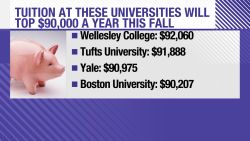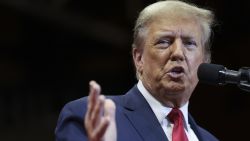Mike Walsh was busy trying to manage his doomed software company in 2009 when he agreed to take a 15 minute meeting with a little-known figure in the tech industry named Ryan Graves.
Graves, a friend of one of Walsh’s employees, was debating whether to take a job as the CEO of UberCab, a new startup looking to let customers hail black cars on demand from their smartphones. He had effectively found and applied for the position on Twitter (TWTR), in response to a tweet from one of the company’s two cofounders, Travis Kalanick.
Walsh saw the potential for a company to improve on existing car services where you “wait 45 minutes for a taxi and then they cancel on you.” He also had a “good feeling” about Graves and knew the founders were well-connected. So not only did Walsh encourage Graves to take the job, he also said he’d invest in the startup if Graves joined UberCab.
As Walsh put it in a recent interview with CNN Business, he figured the “worst case scenario” for UberCab was that “somebody would buy this thing.” Instead, backing the startup ended up being one of the best possible investments a venture capitalist could make this century.
In 2010, Walsh invested $10,000 in UberCab, with half of that coming from a deposit he’d previously put down for a Tesla. Today, Walsh says his investment in the company – now known simply as Uber – is worth tens of millions of dollars. More remarkable: It was just Walsh’s second venture investment.
Walsh was one of a small number of investors who participated in Uber’s first round of funding in 2010. The startup raised $1.25 million at a reported valuation of $4 million. Less than a decade later, Ubermade its Wall Street debut with a valuation of nearly $80 billion.
Investors who participated in that first Uber funding round earned staggering financial returns, bragging rights within the industry and front row seats to the rise of a company that would go on to shake up transportation and labor markets around the world. They watched as Uber raised unprecedented sums from seemingly every major venture capital firm, making it the most valuable startup in the US. In later years, they also watched as Uber was upended by its own brash internal culture.
For a more established venture capitalist like Chris Sacca, the early Uber bet cemented his reputation as an unparalleled angel investor and helped land him on the cover of Forbes. For others like Walsh, being part of this elite group was more transformational. It paved the way for him to transition from running a “disaster” company to building a venture capital firm of his own.
A little luck and some tweets
Like Walsh, many of the first investors discovered Uber through connections to one of the members of the original triumvirate that ran the company: Graves, Uber’s first employee and CEO; Kalanick, the cofounder who replaced Graves as CEO and built the company into a global force, and Garrett Camp, the serial entrepreneur who cofounded Uber.
“There’s always a degree of luckand future opportunity based on past associations,” said Scott Belsky, an early-stage investor and entrepreneur, who invested in that seed funding round.Belsky had previously collaborated with Camp on business partnerships.
In mid-2010, Camp, then best known for launching a discovery tool called StumbleUpon, shared cryptic, emoticon-filled posts on Twitter about a new service called UberCab. “3 cars on the road tonight in SF…,” he wrote in one tweet on May 29, 2010. “@UberCab is running smoothly :)” A couple weeks later, he wrote: “My first @UberCab pickup from SFO. So awesome :)”
The Twitter activity caught the attention of Rob Hayes, a partner at First Round Capital, a venture firm that had invested in StumbleUpon. On June 15, 2010, Hayes sent a short email to Camp: “I’ll bite.” Within weeks, he was negotiating terms of a deal with Camp and Graves.

“My wife always says the best way for me to get into a deal is to schedule a vacation. I ended up negotiating the term sheet over fourth of July weekend,” Hayes told CNN Business. “I remember finding a spot outside of a lumberyard in Brookings, Oregon, that had decent enough cell coverage.”
Hayes’ firm would ultimately lead the first investment round in UberCab. A few months later, Hayes looked at growth metrics for the service and told Kalanick he “might have a tiger by the tail.” Hayes recalled Kalanick grinned in response, thinking the same thing.
Then the tiger got loose.
Bump in the road
Under Kalanick’s leadership, Uber bulldozed ahead of its rivals through a mix of aggressive fundraising, dirty tricks and a take-no-prisoners attitude toward expansion in the US and abroad. He pushed to expand Uber by investing in self-driving cars, meal deliveries and freight shipping.
But in 2017, Uber was derailed by allegations of sexism and harassment and a damning investigation into its workplace culture. At one point, Kalanick was caught on camera arguing with an Uber driver, forcing him to admit he needed to “fundamentally change as a leader and grow up.”
The scandals forced some longtime investors to grapple with whether to support the founder who had built Uber into a behemoth or advocate for leadership changes to reform the company culture and safeguard Uber’s future.
A group of investors, including the venture capital firm Benchmark, pressured Kalanick to resign, which he ultimately did in June 2017. Soon after, a different group of the startup’s investors retaliated against Benchmark in a clear sign of divisions among the Uber faithful.
Even now, nearly two years later, some investors are hesitant to talk about that period.
“I don’t think there’s anyone else on the planet who could have built this company [other than Travis],” Walsh said. And yet, one of his firm’s core principles was that “we believe in values as much as valuations.” The scandals “tested that,” he said.
While Walsh continued to believe that “Uber is the bomb,” the scandals nonetheless left him feeling envious of Uber’s chief rival in at least one sense. “I wish it was more the warm fuzzy Lyft kind of story.”

























